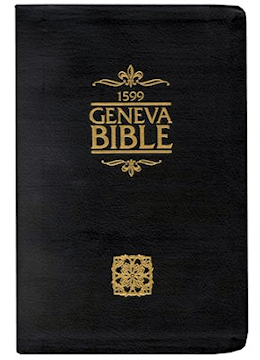Textus Receptus Bibles
Geneva Bible 1560/1599
| 4:1 | Ye masters, doe vnto your seruants, that which is iust, and equall, knowing that ye also haue a master in heauen. |
| 4:2 | Continue in prayer, and watch in the fame with thankesgiuing, |
| 4:3 | Praying also for vs, that God may open vnto vs the doore of vtterance, to speake ye mysterie of Christ: wherefore I am also in bonds, |
| 4:4 | That I may vtter it, as it becommeth mee to speake. |
| 4:5 | Walke wisely towarde them that are without, and redeeme the season. |
| 4:6 | Let your speach be gracious alwayes, and powdred with salt, that ye may know how to answere euery man. |
| 4:7 | Tychicus our beloued brother and faithfull minister, and fellow seruant in the Lord, shall declare vnto you my whole state: |
| 4:8 | Whom I haue sent vnto you for the same purpose that he might know your state, and might comfort your hearts, |
| 4:9 | With Onesimus a faithfull and a beloued brother, who is one of you. They shall shew you of all things here. |
| 4:10 | Aristarchus my prison fellow saluteth you, and Marcus, Barnabas cousin (touching whom ye receiued commandements. If he come vnto you, receiue him) |
| 4:11 | And Iesus which is called Iustus, which are of the circumcision. These onely are my worke fellowes vnto the kingdome of God, which haue bene vnto my consolation. |
| 4:12 | Epaphras the seruant of Christ, which is one of you, saluteth you, and alwayes striueth for you in prayers, that ye may stand perfect, and full in all the will of God. |
| 4:13 | For I beare him record, that he hath a great zeale for you, and for them of Laodicea, and them of Hierapolis. |
| 4:14 | Luke the beloued physician greeteth you, and Demas. |
| 4:15 | Salute the brethren which are of Laodicea, and Nymphas, and the Church which is in his house. |
| 4:16 | And when this Epistle is read of you, cause that it be read in the Church of the Laodiceans also, and that ye likewise reade the Epistle written from Laodicea. |
| 4:17 | And say to Archippus, Take heede to the ministerie, that thou hast receiued in the Lord, that thou fulfill it. |
| 4:18 | The salutation by the hand of me Paul. Remember my bands. Grace be with you, Amen. |

Geneva Bible 1560/1599
The Geneva Bible is one of the most influential and historically significant translations of the Bible into English, preceding the King James translation by 51 years. It was the primary Bible of 16th century Protestantism and was the Bible used by William Shakespeare, Oliver Cromwell, John Knox, John Donne, and John Bunyan. The language of the Geneva Bible was more forceful and vigorous and because of this, most readers strongly preferred this version at the time.
The Geneva Bible was produced by a group of English scholars who, fleeing from the reign of Queen Mary, had found refuge in Switzerland. During the reign of Queen Mary, no Bibles were printed in England, the English Bible was no longer used in churches and English Bibles already in churches were removed and burned. Mary was determined to return Britain to Roman Catholicism.
The first English Protestant to die during Mary's turbulent reign was John Rogers in 1555, who had been the editor of the Matthews Bible. At this time, hundreds of Protestants left England and headed for Geneva, a city which under the leadership of Calvin, had become the intellectual and spiritual capital of European Protestants.
One of these exiles was William Whittingham, a fellow of Christ Church at Oxford University, who had been a diplomat, a courtier, was much traveled and skilled in many languages including Greek and Hebrew. He eventually succeeded John Knox as the minister of the English congregation in Geneva. Whittingham went on to publish the 1560 Geneva Bible.
This version is significant because, it came with a variety of scriptural study guides and aids, which included verse citations that allow the reader to cross-reference one verse with numerous relevant verses in the rest of the Bible, introductions to each book of the Bible that acted to summarize all of the material that each book would cover, maps, tables, woodcut illustrations, indices, as well as other included features, all of which would eventually lead to the reputation of the Geneva Bible as history's very first study Bible.